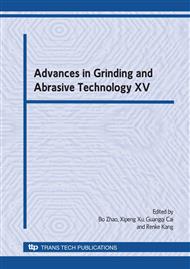p.477
p.482
p.487
p.492
p.497
p.504
p.509
p.514
p.519
Research on a Colloid Jet Polishing Equipment and its NC Interpolation Algorithm for Rotary Symmetric Aspheric
Abstract:
Colloid jet polishing (CJP) is a new technique for the ultraprecision machining of aspheric surfaces, especially for the ultrasmooth surfaces machining of small-radiused concave surfaces and freeform surfaces. In this paper, a colloid jet polishing equipment with 5 axes, four of which perform linkage movement was developed. According to characteristic of colloid jet polishing, NC interpolation algorithm for rotary symmetric aspheric based on this equipment was researched. The derivation process and computer simulation result of the algorithm was also presented. The interpolation error of this algorithm was analyzed and the calculation formula was also proposed. According to the result of analysis, the precision of the interpolation algorithm is high and the algorithm is very useful. Experiments show that high quality ultrasmooth surface can be achieved using this method and surface roughness Ra less than 1nm for K9 glass can be obtained stably.
Info:
Periodical:
Pages:
497-503
Citation:
Online since:
September 2009
Authors:
Price:
Сopyright:
© 2009 Trans Tech Publications Ltd. All Rights Reserved
Share:
Citation:


